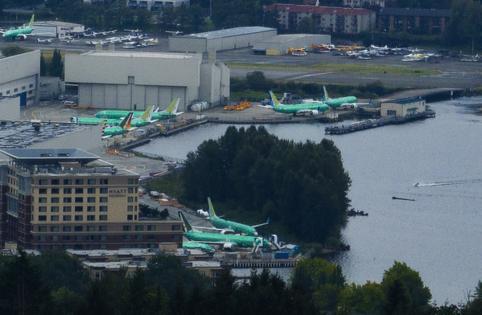Boeing layoff plan suggests deep white-collar job cuts
Published in Business News
SEATTLE — The major Boeing layoffs announced last week will all be involuntary, meaning the company won’t offer severance packages to encourage employees to exit.
And according to the “Reduction In Force” plan presented to Boeing Commercial Airplanes managers Monday, members of the Machinists union will, for now, not be among the 10% of Boeing workers laid off.
That implies heavy cuts among white-collar staff, including engineers, and nonunion salaried employees at all levels up to vice presidents.
Slides from the internal presentation on the “Reduction In Force” obtained by The Seattle Times reveal the criteria to be used to select individuals and work groups for layoff.
A timeline presented shows two phases of layoffs planned.
Managers are expected to finalize their decisions on who gets laid off by the end of this month. Then, after oversight and compliance reviews, between Nov. 13 and Nov. 15, they will give the first wave of affected employees 60-day layoff notices that their jobs will end on Jan. 17.
A second phase, “if needed” to achieve the targeted 10% head-count cut, will see more layoffs on Feb. 21.
In response to questions about the plan, Boeing said those affected will have to work for only a couple of weeks after they are notified of their impending layoff.
They will continue to be paid until their layoff date, giving them some time — interrupted by the Thanksgiving and Christmas holidays — to look for other work.
Boeing said the company is “in the infancy stage of putting this together” and that the dates stated in Monday’s presentation may shift by a day or two.
The targeted cut represents about 17,000 people companywide
Boeing said the plan to cut 10% may be handled differently in other business units, including the Defense & Space division, the Global Services division and employees in the headquarters unit.
Who will be tapped for layoff?
The slides indicate the Commercial Airplanes leaders will use a series of criteria to identify individuals or units for layoff. They are instructed to consider employees at all levels, including executives and managers.
Natural attrition as employees leave for other companies or retire will be counted toward the reduction target.
Laying off non-employee contractors will count toward the head count goal. However managers are instructed not to count specialized contractors whose employment was already time-limited.
For direct employees, poor performance is the first filter on the list. “Lower performers” can be let go. High cost is next, including overhead costs for the individual or work unit.
Managers are also asked to identify “work we can de-prioritize and stop doing.” And they should consider which skills are essential to retain and which are not.
So eliminating roles no longer deemed necessary provides another way to reach the layoff target.
The list of criteria states that managers must consider whether an individual’s work spans multiple layers of the Commercial Airplanes organization. Asked what this meant, Boeing said that in making layoff decisions leaders are being asked to take into account the reporting structure of the organization, with the goal to make it “flatter and more efficient.”
Additionally, managers are told to consider the “return to office” push. Whether an employee is working remotely or in-person can be a factor in the decision.
Machinists are safe, for now
Not included in the plan are production and maintenance employees at Boeing South Carolina. Likewise excluded are members of the Machinists union District 751 and the Portland, Oregon, Machinists unit, District W24 — although the slide stating this adds, in parentheses, “at this time.”
Excluding the blue-collar workforce highlights how the layoff plan has little to do with the Machinist strike. It’s a restructuring by new CEO Kelly Ortberg designed to address the broader and deeper problems Boeing faces.
Ever since the Alaska Airlines fuselage panel blowout in January, Boeing has been in dire trouble, bleeding cash. Jet production rates slowed to a crawl as Boeing sought to convince the Federal Aviation Administration that it has gained control of quality management inside the factories.
The only way forward for Boeing is to start building planes again and to ramp up production back to the rates planned before the January blowout. To achieve those rates, it had been hiring machinists at a rapid clip. Whenever the strike ends, it will need all those machinists ready to swing into action.
However, the Reduction in Force plan has no such reassurance for engineers. Even in South Carolina, only production work is explicitly excluded from layoff.
The exclusion for now of 33,000 Machinists from the planned cuts means that Boeing can reach the 10% target stated in the slides for the Commercial Airplanes unit only through deep cuts among the white-collar staff, including engineers and nonunion salaried employees.
In the past, when Boeing needed to slash jobs, for example during the 2008 global financial crisis and then in the industry downturn due to the COVID-19 pandemic, it softened the impact by offering severance packages to those willing to leave.
Not this time. “No voluntary layoffs will be offered,” the plan states. Presumably that’s because in its current dire financial state, Boeing cannot afford to offer such enticements.
Allowing those laid off to stop working and still be paid until the official layoff dates is the only softening in the Commercial Airplanes plan.
Creating immense uncertainty and worry, Boeing employees must now wait for more than four weeks to learn their fate.
_____
©2024 The Seattle Times. Visit seattletimes.com. Distributed by Tribune Content Agency, LLC.












Comments